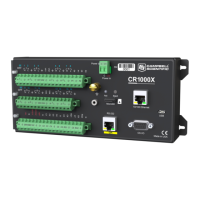Resistive-Bridge Type and
Circuit Diagram
CRBasic Instruction and
Fundamental Relationship
Relational Formulas
Full Bridge
1,2
CRBasic Instruction:
BrFull()
Fundamental Relationship:
These relationships
apply to
BrFull()
and BrFull6W()
Six Wire Full Bridge
1
CRBasic Instruction:
BrFull6W()
Fundamental Relationship:
1
Key: V
x
= excitation voltage; V
1
, V
2
= sensor return voltages; R
f
= fixed, bridge or completion resistor; R
s
=
variable or sensing resistor.
2
Campbell Scientific offers terminal input modules to facilitate this measurement.
Offset voltage compensation applies to bridge measurements. In addition to RevDiff and
MeasOff parameters discussed in Minimizing offset voltages (p. 57), CRBasic bridge
measurement instructions include the RevEx parameter that provides the option to program a
second set of measurements with the excitation polarity reversed. Much of the offset error
inherent in bridge measurements is canceled out by setting RevDiff, RevEx, and MeasOff
to True.
Measurement speed may be reduced when using RevDiff, MeasOff, and RevEx. When
more than one measurement per sensor is necessary, such as occurs with the BrHalf3W(),
BrHalf4W(), and BrFull6W() instructions, input and excitation reversal are applied
separately to each measurement. For example, in the four-wire half-bridge (BrHalf4W()),
6. Measurements 65

